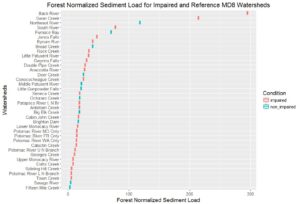Chesapeake Bay Watershed Model assistance
Interstate Commission on the Potomac River Basin
Chesapeake Bay Watershed Model: Phase 6
ICPRB have been actively participating in the development of Phase 6 of the Chesapeake Bay Watershed Model (P6) as a member of the CBP Modeling work Team for the past six years. ICPRB staff have also used their understanding of the model to help Maryland Department of the Environment (MDE) evaluate P6 for use in the development of local sediment TMDLs.
Based on the evaluation by ICPRB, additional factors that may affect the applicability of P6 output for local TMDL development include P6’s representation of the fate and transport of sediment in developed areas, namely:
- applying delivery factors (or interconnectivity factors, as they are called in P6) based primarily on topography may not be appropriate in developed areas where much of the transport takes place in storm sewers;
- there is nothing in the P6 development process that ensures that edge-of-small steam loads from developed land uses are generally in the range of outfall monitoring data collected under the municipal separate storm sewer system (MS4) permitting program; and
- the hydrological impacts on streambank erosion of stormwater best management practices (BMPs) are not explicitly represented in P6, and there is enough reason to question whether the P6 sediment simulation will provide a basis for developing local sediment TMDLs that will be acceptable to stakeholders.
TMDLs in Maryland
 At MDE’s request, ICPRB evaluated the feasibility of using the existing TMDL methodology (based on P5) with the P6 simulations in its current state to develop local sediment TMDLs in Maryland. The findings of this effort were that there was no clear separation in forest normalized loads between the impaired and non-impaired watersheds, besides, it is not plausible that erosion rates throughout the Bay watershed equal the average Bay watershed erosion rate.
At MDE’s request, ICPRB evaluated the feasibility of using the existing TMDL methodology (based on P5) with the P6 simulations in its current state to develop local sediment TMDLs in Maryland. The findings of this effort were that there was no clear separation in forest normalized loads between the impaired and non-impaired watersheds, besides, it is not plausible that erosion rates throughout the Bay watershed equal the average Bay watershed erosion rate.
These findings prompted ICPRB to propose an alternative methodology, the “strawman approach”, should MDE prefer using outputs from the P6 model. In this approach, adjusting P6 streambank erosion and floodplain deposition to ensure that instream sediment loads are redistributed based on assessed sediment impairment would ensure that stream segments that are assessed to generate a greater proportion of sediment load relative to other areas are assigned that proportion of sediment load within the watershed.
The “strawman approach” would supposedly solve issues associated with sediment TMDL development, however, it did not address other concerns associated with phosphorus TMDL development.
ICPRB will continue to work with the CBP modeling team on the development of Phase 7 of the Bay watershed model (P7), which is set to be completed in 2025.
